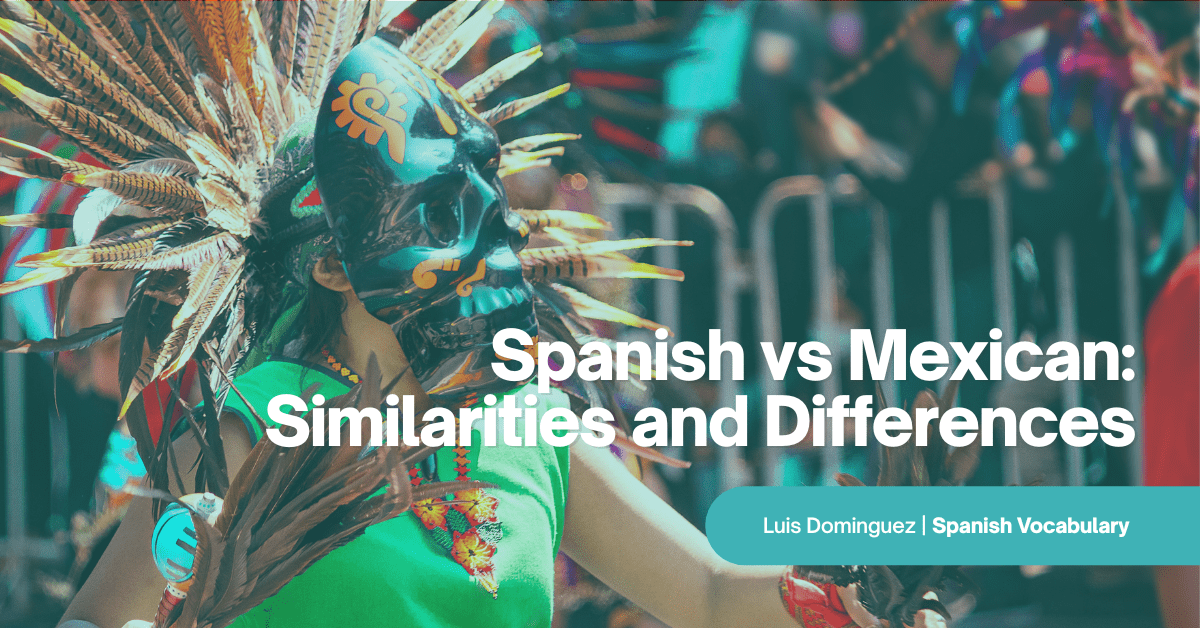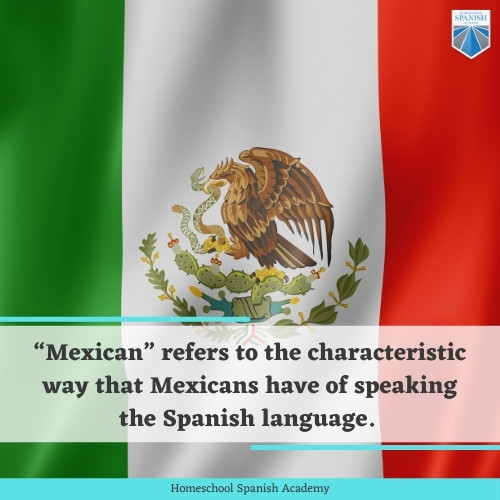
Spanish vs Mexican: Similarities and Differences
The Spanish vs Mexican debate refers to the way people speak Spanish in Spain and Mexico. While citizens of both countries speak Spanish, they do it in different and characteristic ways.
Why does that happen?
Why does the same language sound so different depending on where you hear it?
Why can’t Mexicans and Spaniards get together and agree on how to speak their own language (and in the process make it easier for students of Spanish all over the world)?
Today, I’ll answer these questions and many more, such as:
- Is Spanish the same as Mexican?
- Is there such a thing as a Mexican language?
- Why do Mexicans speak Spanish?
- What’s the Spanish lisp?
And I’ll also introduce you to the biggest differences and similarities between the Spanish from Spain and the one spoken in Mexico.
Is Spanish the Same as Mexican?
Let me be clear from the start: there’s not such a thing as a Mexican language. Just as there’s no American language. When someone who’s speaking about languages refers to “Mexican,” they’re talking about the characteristic way that Mexicans have of speaking the Spanish language.
So, is Spanish the same as Mexican? Yes and no.
Let me explain myself.
They’re the same, because even though people may call them different names, they’re referring to the same language: Spanish.
However, they’re not the same as each variant of the Spanish language is unique and has its own specific characteristics. And here I’m not only talking about Spanish vs Mexican, but about The Differences between Latin American and Castilian Spanish too.

A Bit of Mexican (and Spanish) History
To fully understand the Spanish vs Mexican question, I recommend you read A Brief History of Latin America and A Crash Course in the Gripping History of the Spanish Language. Here, I won’t go as deep as my colleagues did in those posts, but I’ll still explain briefly where this confusion between Spanish and Mexican may come from.
It was the year 1492, and the Spanish monarchs decided to invest in a Genoan sailor with grandeur delusions. Somehow that sailor (named Christopher Columbus) reached a continent previously unknown by the Europeans. Because the Spanish kings paid for the trip, they considered all the territories discovered by Columbus and subsequent explorers to be theirs. That meant that a lot of Spaniards started making the trip across the Atlantic and settling in what is now known as Latin America.
Mexico was one of the first territories on the mainland to be conquered, and ever since then Spanish has been spoken in these lands. Tenochtitlan, the capital of the Aztec Empire that ruled Mexico before the arrival of the Spaniards, fell on August 13, 1521. That makes exactly 500 years of the Spanish language being spoken in Mexico.
So, Why is Mexican Spanish Different?
For the same reason that American English is different from British English and from Australian English. Because languages are living creatures that evolve with time and develop region-specific characteristics.
The geographical separation between Mexico and Spain meant that during these last 500 years of history, the variant of Spanish on each side of the Atlantic evolved in different ways, incorporating new words from different sources and influences.
That’s how we come to the point of even considering the possibility of a Spanish vs Mexican debate. The truth is that even though there are many differences between Mexican Spanish and the Spanish spoken in Spain, the main body of the language is still the same.
How do I know it?
Because I’m a Mexican who lived in Spain for three years of my life, and I can tell you that I was able to communicate without any problem with the locals and they seemed to understand me very well. Although now that I think about it, they did make fun of my accent sometimes.
Spanish vs Mexican
Let’s take a deep look at the differences and similarities between “Castilian” Spanish (originally from the region of Castilla in Spain), which is the dialect spoken in Spain, and Mexican Spanish:
Similarities
In the Spanish vs Mexican debate, the easy part is to find the differences between the dialects. Because they’re one and the same language, it’s easier to identify where they differ than where they agree, as they agree in pretty much everything else.
Both dialects share the same grammar and structure. They both have the same moods and tenses, conjugation rules, and everything else that you learn during your Spanish studies. As I said, they’re the same language, so I can’t look for similarities in two things that are actually the same thing. What I can do is help you find where they diverge and identify the differences between them.
Differences
When talking about Spanish vs Mexican, you quickly notice that two main differences exist between the dialects, and then you have many other little divergences of vocabulary. Let’s start with the most noticeable one: pronunciation.
1. Pronunciation
If you live in the US and your exposure to Spanish comes from interaction with Latin people, watching Mexican telenovelas, or Latin American films on Netflix, then you’ll easily notice the difference in pronunciation the first time you visit Spain or speak with a Spaniard.
Spanish people have a characteristic way of speaking that some people even confuse as a lisp. It’s nothing like that, and I recommend you to read What’s the Spanish Lisp? All About the Ceceo, where I explain in detail the origins of this particular way of speaking. Here, let’s just say that this difference in pronunciation has a name: ceceo.
Ceceo occurs “when the letters s, c (before e and i), and z are pronounced using the inter-dental fricative.” You can identify this sound as the “th” sound in English, as in “thing.” Mexicans, on the other hand, sesean, which is the opposite practice. Sesear means to pronounce each of these letters (s, c, and z) as the English “s.”
Seems like a small difference, but it produces a great effect in the way people perceive the pronunciation of the Spanish language.
2. Vosotros/Ustedes
When I was a kid, I learned all the Spanish verbs conjugations with vosotros as the second person of plural, and I could never understand why I was learning something that I’d never use. That’s how Spanish people speak, and it was always the most difficult conjugation for us Mexican kids to learn, as we’d never heard it before.
In a way, the Spanish vs Mexican discussion is a vosotros vs ustedes one.
Just like there are two options within the second person singular pronouns: tú (informal) and usted (formal), there are also two options in the second person plural: vosotros (informal) and ustedes (formal).
In Mexico, nobody uses vosotros. Instead, people use ustedes, and that has nothing to do with formality, it’s just the way the language evolved in this country. Maybe in the past, it had something to do with formality and social rules, but then society changed and the extended use of ustedes stayed as the norm.
Most Mexicans aren’t even aware that their way of speaking is considered more formal than the way Spanish people speak.
Let’s see a couple of examples of verbs conjugated in present tense of indicative with vosotros and ustedes:
Verb: comer (to eat)
Vosotros: coméis
Ustedes: comen
Verb: dormir (to sleep)
Vosotros: dormís
Ustedes: duermen
Verb: hablar (to talk)
Vosotros: habláis
Ustedes: hablan
3. Vocabulary
The differences in vocabulary are many and the reasons for that are varied. Mexican Spanish is heavily influenced by indigenous words, and its close relationship with the United States means that American English also plays a role in the way many words are coined, especially neologisms or new words related to technology mostly.
The influences in the Spanish from Spain come from different places like France and North Africa for example, and that’s how these dialects keep evolving in different ways over time.
Let’s see some of the most common differences in vocabulary in the Spanish vs Mexican argument:
| Spanish | Mexican |
| ordenador (computer) | computadora |
| patata (potato) | papa |
| pavo (turkey) | guajolote |
| mando a distancia (remote control) | control remoto |
| melocotón (peach) | durazno |
| guisante (pea) | chícharo |
| bolígrafo (pen) | pluma |
| gafas (glasses) | lentes |
| teléfono móvil (cell phone) | teléfono celular |
| pajilla (straw) | popote |
| conducir (to drive) | manejar |
| cola (glue) | pegamento |
| repollo (cabbage) | col |
| remolacha (beetroot) | betabel |
Final Thoughts on the Spanish vs Mexican Debate
There are definitely more similarities than differences between the Spanish and Mexican variants of the language. The Spanish language has served as an instrument to bring together these two lands and peoples that otherwise may have been much more different.
The Spanish vs Mexican debate is an interesting way of understanding how languages evolve and how they stay the same. Because it’s amazing that after 500 years of being apart, Mexicans and Spaniards can still understand each other without any trouble. That’s the magic of language!
Sign up for a free class to speak Spanish today with one of our certified teachers from Guatemala, and practice your new Mexican and Spanish vocabulary!

Ready to learn more Spanish vocabulary? Check these out!
- Earth Day Projects for Kids + Spanish Earth Day Vocabulary
- How to Talk About the Temperature in Spanish: Fahrenheit, Celcius, and Descriptions
- Car Parts Spanish Vocabulary List: Learn Using Pictures
- Top 15 New Year’s Resolutions in Spanish
- Talk About Hurricanes And The Weather in Spanish
- Spanish Words with Multiple Meanings in Latin America
- World Mental Health Day: A Vocabulary Guide for Mental Health Workers
- Expressing Appreciation in Spanish on World Teachers’ Day
- Language Learning with Netflix: How to Use the Chrome Extension - April 18, 2024
- 23 Common Spanish Prepositions You Can Use Today - March 27, 2024
- 25 Common Subjunctive Phrases in Spanish Conversation - March 21, 2024




